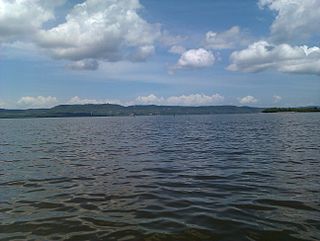Location
The Canavieiras Extractive Reserve is divided between the municipalities of Belmonte (2.65%), Canavieiras (11.51%) and Una (0.38%) in Bahia and a strip of coastal waters. It has an area of 100,646 hectares (248,700 acres). The reserve includes 85,000 hectares (210,000 acres) of sea, 12,000 hectares (30,000 acres) of mangroves and 3,000 hectares (7,400 acres) of land. The land is flat, rising to no more than 10 metres (33 ft) above sea level. Average annual rainfall is 2,000 millimetres (79 in). Temperatures vary from 20 to 30 °C (68 to 86 °F) with an average of 24 °C (75 °F).
History
The Canavieiras Extractive Reserve was created by presidential decree on 5 June 2006. It is administered by the Chico Mendes Institute for Biodiversity Conservation. It became part of the Central Atlantic Forest Ecological Corridor, created in 2002. It is classed as IUCN protected area category VI (protected area with sustainable use of natural resources). An extractive reserve is an area used by traditional extractive populations whose livelihood is based on extraction, subsistence agriculture and small-scale animal raising. Its basic objectives are to protect the livelihoods and culture of these people and to ensure sustainable use of natural resources.
The deliberative council was created on 3 September 2009. On 16 December 2009 the Instituto Nacional de Colonização e Reforma Agrária (INCRA: National Institute for Colonization and Agrarian Reform) recognised the reserve as supporting 1,300 families, who would qualify for PRONAF support. On 5 December 2015 ICMBio granted the Associação Mãe dos Extrativistas da Reserva Extrativista de Canavieira (AMEX) the right of use for 20 years. A profile of the beneficiary families was published on 5 August 2016.

Corumbau Marine Extractive Reserve is a coastal marine extractive reserve in the state of Bahia, Brazil. The reserve was created in 2000 to help protect the traditional local fishing economy, which was suffering from predatory commercial fisheries. It includes an area of corals and rich marine biodiversity, and a breeding ground for humpback whales. Growth in tourism has caused a surge in real estate prices and introduced new social problems among the traditional residents.

The Acaú-Goiana Extractive Reserve is an extractive reserve in the states of Paraíba and Pernambuco, Brazil.

The Médio Juruá Extractive Reserve is an extractive reserve in the state of Amazonas Brazil.
The Cassurubá Extractive Reserve is an extractive reserve in the state of Bahia, Brazil.

The Baía do Iguape Marine Extractive Reserve is a marine extractive reserve in the state of Bahia, Brazil. As of 2002 the reserve supported about 5,000 people engaged in fishing and shellfish collection.
The Extremo Norte do Tocantins Extractive Reserve is an extractive reserve in the state of Tocantins, Brazil.
The Chapada Limpa Extractive Reserve is an extractive reserve in the state of Maranhão, Brazil.
The Lago do Cuniã Extractive Reserve is an extractive reserve in the state of Rondônia, Brazil.

The Prainha do Canto Verde Extractive Reserve is a marine extractive reserve in the state of Ceará, Brazil.
The Mocapajuba Marine Extractive Reserve is a coastal marine extractive reserve in the state of Pará, Brazil.
The São João da Ponta Extractive Reserve is a coastal marine extractive reserve in the state of Pará, Brazil.

The Mestre Lucindo Marine Extractive Reserve is a coastal marine extractive reserve in the state of Pará, Brazil.
The Cuinarana Marine Extractive Reserve is a coastal marine extractive reserve in the state of Pará, Brazil.
The Chocoaré - Mato Grosso Extractive Reserve (Portuguese: Reserva Extrativista Chocoaré - Mato Grosso is an extractive reserve in the state of Pará, Brazil.
The Caeté-Taperaçu Marine Extractive Reserve is a coastal marine extractive reserve in the state of Pará, Brazil.
The Araí-Peroba Marine Extractive Reserve is a coastal marine extractive reserve in the state of Pará, Brazil.
The Gurupi-Piriá Marine Extractive Reserve is a coastal marine extractive reserve in the state of Pará, Brazil.
The Delta do Parnaíba Marine Extractive Reserve is a coastal marine extractive reserve in the states of Maranhão and Piauí, Brazil.
The Batoque Extractive Reserve is an extractive reserve in the state of Ceará, Brazil.
The Rio Jutaí Extractive Reserve is an extractive reserve in the state of Amazonas, Brazil.
This page is based on this
Wikipedia article Text is available under the
CC BY-SA 4.0 license; additional terms may apply.
Images, videos and audio are available under their respective licenses.






